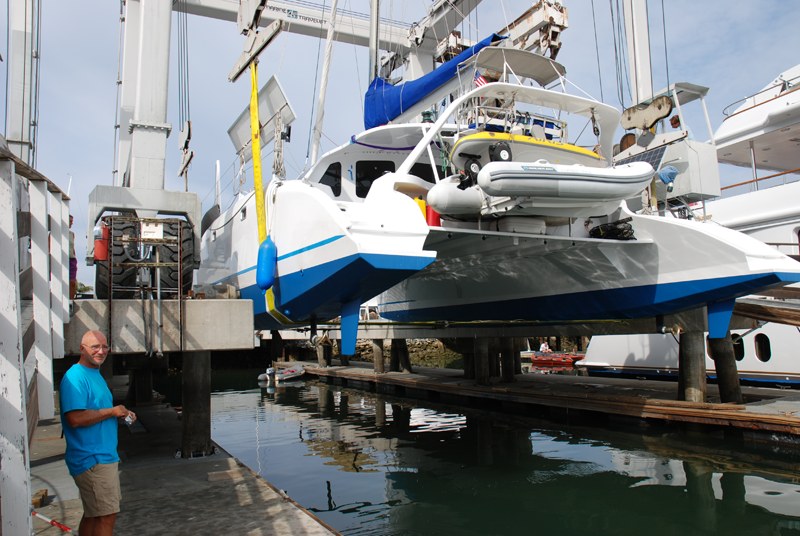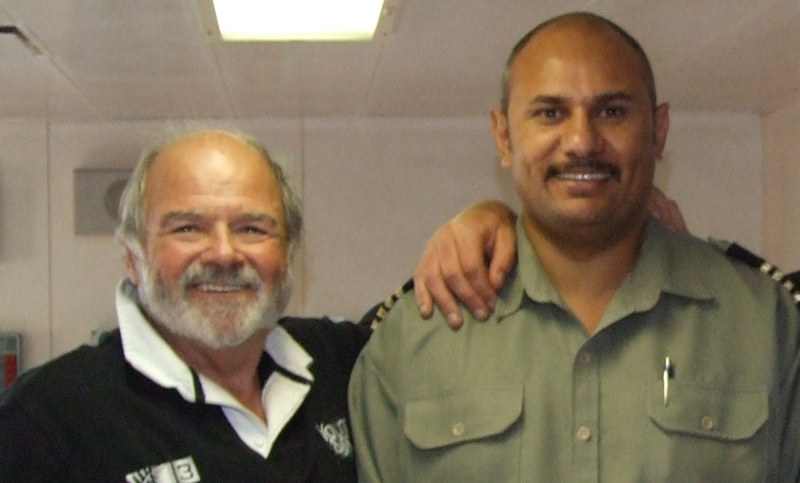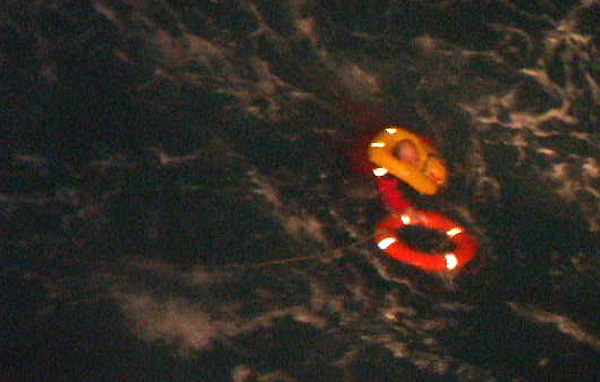
Hauling for Less

© Latitude 38 Media, LLC
You know how everything is less expensive in Mexico? Well, it’s not. Take hauling out your boat.
Most folks who cruised Mexico this winter figured it would be much less expensive to have their boats hauled out down there than when they came back up to the States. But that’s not proving to be true.
One of the reasons is the bad economy in the United States. Business at boatyards in the States is way down. Since the government isn’t going to bail out boatyards like they did the auto companies and banks, and since boatyards aren’t supported by taxpayers, they’ve had to become leaner and more competitive than ever. The yards and their workers are trying to be more efficient than ever, passing on the savings to their customers to increase business.
Jim Milski of the Lake City, Colorado, Schionning 49 Sea Level did a lot of comparison shopping in Mexico and California before he hauled his cat. When he compared the numbers, he decided the most economical choice was Driscoll Boatyard in San Diego, where he stopped after completing his bash. The price he got from Driscoll’s was a little less expensive than Napa Valley Marina, and less than any of the yards in Mexico — although not by a large amount.
Milski’s decision wasn’t based only on price. He felt more confident hauling at an American yard than a Mexican yard because he believed the former was much more likely to have insurance in case something went wrong — such as his cat being dropped. It didn’t hurt that he hauled at a yard where the workforce was extremely experienced and where the same people working on his boat also work on multimillion dollar yachts. Convenience was another factor. Jim and his wife Kent could also walk from their hauled-out boat to the Joe Cocker concert at Humphreys on the Bay!
Milski was a happy guy when his boat touched water again early this week, feeling that he’d gotten both an excellent deal and quality work. "It pays to comparison shop," he said with a smile.
That’s particularly true in these times, when it seems that boatyards up and down the coast have sharpened their pencils when it comes to quoting prices for haulouts and other work. If you were to haul your boat right now, there is a good chance it will cost you less than it did a year ago. So if you’re in Northern California, page through the latest Latitude and dial boatyard numbers for the best deals in years — then get haulin’.
‘Sumatra II’ Skipper Recovering from Loss

©2009 Latitude 38 Media, LLC
"I think the actual grieving over the loss of Sumatra may come later," explains Dr. Jerry Morgan, 71, whose beloved Trintella 53 sank late last month in near-cyclone conditions off Australia. "For now, I’m doing okay, although I’m still having trouble sleeping and can’t seem to shake the nightmares."
Now safely back home in the Bay Area, Jerry is resigned to accepting the loss of his uninsured yacht and getting on with his life — especially since he knows that he came very close to drowning during his heroic rescue by the crew of the 320-ft container ship Scarlett Lucy.

©2009 Latitude 38 Media, LLC
We can honestly say, we don’t recall ever running into Jerry over the years when he wasn’t grinning ear-to-ear, and his eternally upbeat attitude will undoubtedly serve him well as he transitions back into the mainstream after six wonderful years of cruising Central America and the South Pacific. During that time he shared his adventures with a wide variety of crew members, all of whom were horrified to learn of Sumatra II‘s sinking, after she was slammed by a particularly ferocious 30-ft wave while en route to Brisbane, Australia, from New Caledonia. The bashing apparently exacerbated damage done to the sloop’s keel when she dragged anchor onto a reef in a New Caledonian lagoon. Jerry says that assuming the gouges in the keel were superficial, and deciding not to haul her immediately, were crucial mistakes that could easily have cost him and his Kiwi crewman, Stewart McCreadie, 38, their lives.
This is yet another case where a satphone played a cruicial roll. When Sumatra II began rapidly taking on water, Jerry activated his 406 EPIRB, then called Coast Guard Alameda directly with his exact lat-long coordinates. Because the location was too far offshore for a helicopter evac, the Australian RCC (Rescue Coordination Centre) launched a series of five fixed-wing aircraft that assisted with the rescue effort. Look for a complete report on Sumatra II‘s sad fate in the July edition of Latitude 38.
West Marine Swivel Testing
In May 15‘s ‘Lectronic Latitude, we reported on John and Gilly Foy’s wild ride through an anchorage after their Kong anchor swivel — which they bought at West Marine a few years earlier — failed. West Marine CEO Geoff Eisenberg was quick to respond to the report. "This is a really big deal to us," Eisenberg told us. "As you would imagine, the last thing we want to do is sell bad products."
To that end, West Marine’s Product Test Lab conducted testing on three differently sized Kong swivels in their Watsonville Support Center. Kevin Osborn, who heads up the company’s Product Development and Quality Management Teams, reported that all swivels held their SWL (safe working load) when pulled straight back (linear tension). "We did find minor deformation on the majority of 1/2" and 5/16" swivels," Osborn noted. The deformations ranged from bowed pins, failure to swivel, failure to release the screw, and extra play in the swivel. "The 1/4" swivels all functioned normally and didn’t deform in the majority of cases."
Osborn’s team then tested several 5/16" swivels with a 90º transverse side load to the swivels’ 4400 lb SWL. "All samples deformed significantly," he reported, "and one deformed to the degree that the load bearing pin came free once the flange spread to the point of failure."
In a conference call with the Italy-based manufacturer, West Marine asked Kong to manufacture their products more consistently as some of the tested swivels didn’t work properly right out of the package. Kong also agreed to change their packaging to instruct users to
- Use Blue Loctite each time the captive screw is set to ensure it doesn’t back out;
- Inspect their ground tackle at least annually to ensure everything is operating properly and thre is no visible deformation;
- State the SWL and suggest using a shackle between the swivel and the shank of the anchor to prevent problems with side loads.
This last suggestion seemed odd to us since our perception was that the point of such a swivel was to not have to use a shackle, thus reducing the number of potential failure points in one’s anchoring set-up. "It all depends on the anchor," Osborn told us. "Flat shank anchors, like the Delta, offer more potential for the swivel to get torqued. A D-shackle will allow the swivel to pivot around the shackle instead of getting bound on the shank." He noted that on anchors that allow more movement, like the CQR, this wouldn’t be much of an issue.
Watch July’s Sightings for a more detailed report, including photos of the tested swivels.
Flag Day on Sunday
Back in 1916, President Woodrow Wilson officially established June 14 as Flag Day. It commemorates the adoption of the U.S. flag, whose design was finalized by the Second Continental Congress in 1777 after that famous sewing job by Betsy Ross.
Being as this coming Sunday is Flag Day, and many sailors like to fly both the Stars and Stripes as well as other flags, we thought it only proper to reprise a short course on flag etiquette that appeared in our October, 2001, issue.
- Boating flags come in two versions, the regular 50-star flag known in nautical lingo at the ensign, and the ‘yacht ensign’ — the one whose blue field features a fouled anchor surrounded by 13 stars. Either is acceptable, although by law, documented vessels are actually required to fly the yacht ensign. For what it’s worth, we’ve never heard of this law being enforced.
- The proper size of the flag is determined by the size of the boat. The rule is 1 inch mininum of horizontal flag measurement for every foot of boat length. When in doubt, err on the next size larger flag. (For example, a 41-ft boat can fly a 48-inch long flag.)
- The ensign or yacht ensign may be flown from either of two locations: the stern of the boat or leech of the aftermost sail. The former is the norm these days simply because leech-flown flags are more prone to foul on modern backstays.
- Flag Day commemorates only the display of the American flag. There are no hard and fast rules regarding when and where other flags are flown, although the custom developed over the years (and the one noted by Chapmans) is to fly them from the starboard spreader on the most forward mast. Club burgees or ‘private signal’ flags may also be flown from the masthead.
For more on on this subject, see ‘Showing Our Colors’ in our website Features section.
